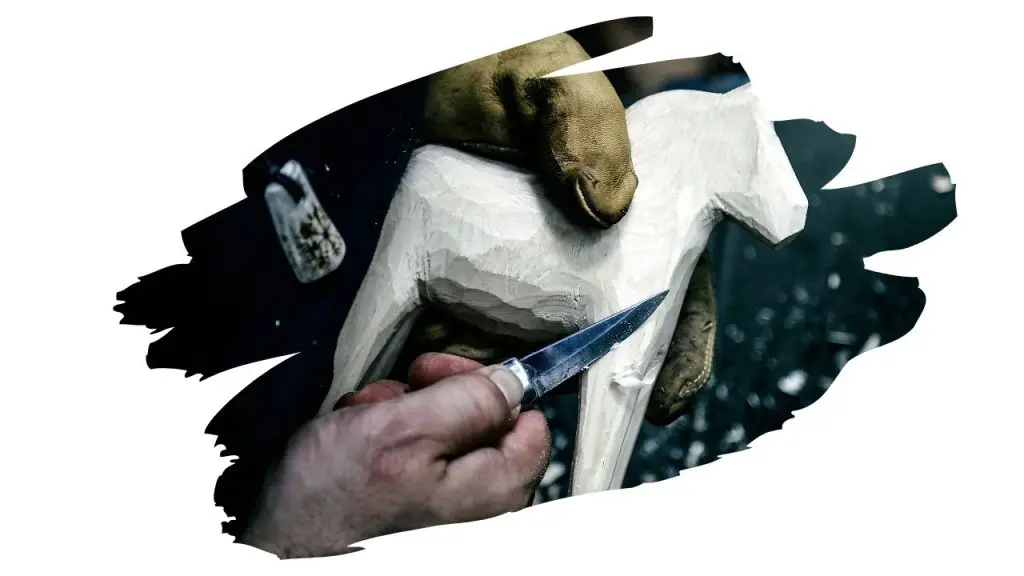Whether you’ve just taken up woodworking as a hobby, or you’ve been whittling wood for a while, you may have heard about a popular lightweight material called Balsa wood.
First used in the 1920’s (as the material of choice for model airplanes), this South American sourced hardwood is one of the softest commercially available hardwoods on the market.
Which brings us back to the main question; Is balsa wood good for carving? Balsa wood, despite being officially classed as a hardwood, is in fact soft enough to be easily used for carving.
There are a number of different wood types that are great for carving sculptures from.
Nevertheless, what makes Balsa a long-standing favorite choice for carvers? Keep reading to find out more…

This post may contain affiliate links to products that we receive a commission for (at no additional cost to you). Learn more here.
Is Balsa Wood Good For Whittling?
Balsa wood has always been a popular choice for making scale-models, such as replica miniature buildings. Its also ideal for wood carving beginners.
And, despite being a relative lightweight in the world of hardwoods, Balsa is surprisingly high-strength pound for pound. So while you can carve easily in to the wood, getting those more intricate detailed designs could prove to be a little bit tricky.
Still, you can use balsa for whittling. And any decent whittling tool will make quick work of it, even when cutting into the grain.
But don’t let Balsas low-density fool you. It may be an easy carving wood, however, you will still need to make sure you use a sharp enough carving tool.
Related Post: Can You Stain Balsa Wood? (Best Practice Revealed!) | TheWoodworkPlace.com
Can Cricut Cut Balsa Wood?
A Cricut Maker can cut through Balsa wood very easily.
These cutting machines are specifically design to carve their way through a range of different materials, from wood and vinyl, to fabric and leather.
But just because you can use a Cricut, doesn’t mean it is the best choice when deciding on which tools you should use to carve with.
Related Post: Can You Really Drill Into Balsa Wood? | The Woodwork Place
What Is The Best Tool To Cut Balsa Wood With?
Well, that depends. Are you cutting through a thick block of Balsa wood? If it is the case that you are cutting through anything more than say a quarter of an inch of Balsa, then using a hand saw will be your best option.
However, if you are looking to carve chips off a small block of Balsa, then a good whittling tool should be suitable enough.
Can You Stain Balsa Wood?
Yes, you can stain Balsa wood, but the loose fiber texture of this hardwood means that the stain job will end up looking blotchy.
If you plan on staining your balsa wood project, then you should probably prepare the wood first by applying a pre-staining finish of Wood Conditioner.
Wood Conditioner is specifically designed to prevent uneven patchy staining on soft porous woods just like Balsa.
Apply a coat of wood conditioner, let it soak into the wood for a good 15 minutes, and then wipe off any excess liquid.
Once done, your Balsa wood project will be ready for an application of any oil-based stain.
Not sure what Wood Conditioner to get? We highly recommend Varathane Premium Wood Conditioner for almost any pre-staining job.
Check out the latest prices for this wood conditioner by visiting Amazon.
Related Post: Can You Put Polyurethane On Balsa Wood? | The Woodwork Place
How Expensive Is Balsa Wood?
The price of Balsa wood comes down to the thickness of the sheet.
A single square foot 1-ply sheet of 5/16” of an inch is around $6.
But a 1-ply sheet at 3/16” can clock in at a pricey $10 per square foot.
But lets compare that price to Basswood (often touted as a wood carvers quick alternative to Balsa wood).
A 13/16” thick board foot of Basswood is priced around $4 to $5 per foot.
The price of wood has been rising in recent years, and there are some very good reasons as to why. Click here to learn more: Why Is Walnut Wood So Expensive?
What Are The Disadvantages Of Balsa Wood?
1 – It Is Not Water Proof
If you are thinking of using Balsa wood to create an outdoor piece, you might want to think again.
What with the rain and damp of the outdoors, you need to ask yourself, is Balsa wood water resistant? Balsa is not waterproof, and even treating the wood with a water sealant won’t be enough to prevent it from soaking all that water up like a sponge – causing it to expand and warp.
2 – It Catches Fire Easily
Contrary to popular opinion, not all woods burn easily.
For example hardwoods are less flammable than softwoods due to the denser wood grain of hardwood timber.
However, Balsa, despite being classed as a hardwood, in fact has a soft loose grain. And the low density of that grain means it burns more quickly and easily.
3 – It Is Not Very Durable
If you want to make a wood craft that can stand the test of time.
Between high water absorption, low heat resistance, and brittle nature, its not really a go-to choice for making pieces that will need to be handled or used a lot.
Final Thoughts
So, is balsa wood good for carving? Balsa wood is soft enough and pliable enough to be used for hand carving craft items.
But it is worth bearing in mind that this hardwood does have a few key disadvantages such as it being;
1. Highly Flammable: It Catches Fire Easily
2. Low Durability: It Is Easy To Break
3. High Water Absorption: It Is Not Suitable For Outdoor Pieces



